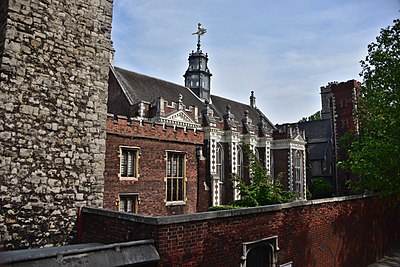The Lambeth Articles of 1595 were a series of nine doctrinal statements intended to be an appendix to the Thirty-nine Articles of the Church of England.[1] In response to a controversy over the Calvinist doctrine of predestination, the Lambeth Articles were created to clarify the church's official teaching. They were drawn up by Regius Professor of Divinity at Cambridge University, William Whitaker, an eminent Reformed theologian. Because Queen Elizabeth I refused to authorise the articles, they never went into effect in England. However, they were adopted by the Church of Ireland in 1615.
Background
editDuring the reign of Elizabeth I, a Calvinist consensus developed among the leading clergy within the Church of England, specifically in regards to the doctrine of predestination. The church's doctrinal statement, the Thirty-nine Articles, addressed predestination in Article 17 ("Of Predestination and Election"). While Calvinists believed in double predestination (that God predestined some people for salvation but others for reprobation), Article 17 only endorsed election to salvation.[2] An Arminian minority emerged in the universities (notably William Barret, Peter Baro, John Overall and Antonio del Corro) and challenged the prevailing Calvinism.[3] Thus a controversy over predestination arose at Cambridge University.
Development
editThe Lambeth Articles (also known as the Nine Articles) were drafted by William Whitaker, Regius Professor of Divinity at Cambridge, in Latin. He had been sent to Archbishop of Canterbury John Whitgift by the heads of Cambridge University, along with Humphrey Tyndal, Dean of Ely, in order to settle the controversy. The Articles were originally drafted by Whitaker and modified later by the bishops to make them more acceptable to anti-Calvinists. They were not intended a replacement for the Thirty-nine Articles but were meant to officially align Article 17 to Calvinist theology.[3] The Articles were adopted and signed by Archbishop Whitgift, Richard Fletcher, Bishop of London, Richard Vaughan, Bishop elect of Bangor, and others at a meeting convened at Lambeth Palace on November 20, 1595.[4]
Content
editThe nine articles adopted at Lambeth can be summarised as follows.[5]
- The eternal election of some to life, and the reprobation of others to death.
- The moving cause of predestination to life is not the foreknowledge of faith and good works, but only the good pleasure of God.
- The number of the elect is unalterably fixed.
- Those who are not predestinated to life shall necessarily be damned for their sins.
- The true faith of the elect never fails finally nor totally.
- A true believer, or one furnished with justifying faith, has a full assurance and certainty of remission and everlasting salvation in Christ.
- Saving grace is not communicated to all men.
- No man can come to the Son unless the Father shall draw him, but all men are not drawn by the Father.
- It is not in every one's will and power to be saved.
Reception
editWhen Queen Elizabeth I discovered that the Articles had been submitted and discussed at a synod without her permission or authority, she was "furious" and ordered that the archbishop recall and suppress the Articles immediately.[3][6] Sir Robert Cecil wrote to Archbishop Whitgift on December 5, 1595, that "[her Majesty] misliked much that any allowance had been given by his Grace [i.e., the Archbishop of Canterbury] and the rest, of any such points to be disputed: being a matter tender and dangerous to weak ignorant minds. And thereupon [...] she required his Grace to suspend them."[7] This was partly due to her unfavourable attitude towards Calvinism in general—she preferred a milder, more compromising approach in her Religious Settlement of 1559 and wished to keep it that way–and partly because Whitgift, although one of her favourites, had acted on a matter of religion without her knowledge or consent, which she wanted to discourage.[6] Whitaker's influence was limited during Elizabeth's reign due to his Calvinist theology which was "too rigid for her tastes", and his ties to radical puritans.[8]
Church of Ireland
editThe Lambeth Articles were accepted at the 1615 Convocation of Dublin and consequently engrafted in the Irish Articles (written by James Ussher). One can find the basis of the Five Points of Calvinism contained in the Canons of Dort (1618–19) in the Lambeth Articles.[4]
References
editNotes
edit- ^ Tyacke 2022, pp. 1082–1117.
- ^ Marshall 2017, p. 56.
- ^ a b c Marshall 2017, p. 60.
- ^ a b Schaff 1878, p. 523.
- ^ Schaff 1877, p. 658.
- ^ a b Gilliam & Tighe 1992, p. 326.
- ^ Gilliam & Tighe 1992, p. 328.
- ^ Gilliam & Tighe 1992, p. 331.
Bibliography
edit- Gilliam, Elizabeth; Tighe, W. J. (1992). "To "Run with the Time" Archbishop Whitgift, the Lambeth Articles, and the Politics of Theological Ambiguity in Late Elizabethan England". The Sixteenth Century Journal. 23 (2).
- Lake, P. G. (February 1987). "Calvinism and the English Church 1570–1635". Past & Present (114). Oxford University Press: 32–76. doi:10.1093/past/114.1.32. JSTOR 650960.
- Marshall, Peter (2017). "Settlement Patterns: The Church of England, 1553–1603". In Milton, Anthony (ed.). The Oxford History of Anglicanism. Vol. 1: Reformation and Identity, c. 1520–1662. Oxford University Press. pp. 45–62. ISBN 9780199639731.
- Schaff, Philip (1877). The Creeds of Christendom: With a History and Critical Notes. Vol. 1. New York: Harper.
- Schaff, Philip (1878). The Creeds of Christendom: The Evangelical Protestant Creeds, with Translations. Vol. 3. New York: Harper.
- Tyacke, Nicholas (2022). "The Lambeth Articles (1595) and the Doctrinal Stance of the Church of England". The English Historical Review. 137 (587). doi:10.1093/ehr/ceac128. ISSN 0013-8266.
Further reading
edit- White, Peter (1992). Predestination, Policy and Polemic: Conflict and Consensus in the English Church from the Reformation to the Civil War. Cambridge University Press. doi:10.1017/CBO9780511520266. ISBN 978-0-521-89250-6.
